
ORSERDU (elacestrant), 345 mg tablets, is indicated for the treatment of postmenopausal women or adult men with estrogen receptor (ER)-positive, human epidermal growth factor receptor 2 (HER2)-negative, ESR1-mutated advanced or metastatic breast cancer with disease progression following at least one line of endocrine therapy.
Breast cancer is a malignant tumor that originates in the cells of the breast, commonly affecting the ducts and lobules. It is the most common cancer among women worldwide, though it can also occur in men. The development of breast cancer involves the abnormal growth of breast cells that can invade surrounding tissues and spread to other parts of the body (metastasize). Risk factors include genetic mutations (such as BRCA1 and BRCA2), family history of breast cancer, hormonal influences, and certain lifestyle factors such as alcohol consumption and obesity.
Early detection through screening methods like mammography, breast self-examinations, and clinical breast exams is crucial for effective treatment and improved survival rates. Treatment options vary based on the stage and subtype of breast cancer and may include surgery, radiation therapy, chemotherapy, hormone therapy, and targeted therapy. Advancements in personalized medicine and ongoing research continue to enhance the understanding and management of breast cancer, leading to more tailored and effective treatment approaches.
Companion diagnostics play a crucial role in the decision to treat breast cancer with the drug ORSERDU (elacestrant). ORSERDU is specifically indicated for the treatment of postmenopausal women or adult men with estrogen receptor (ER)-positive, HER2-negative advanced or metastatic breast cancer with an ESR1 mutation, which has progressed after one or two lines of endocrine therapy. The ESR1 mutation is a specific genetic alteration in the estrogen receptor gene that can affect how breast cancer cells respond to hormone therapy.
Before prescribing ORSERDU, a companion diagnostic test is used to detect the presence of ESR1 mutations in tumor DNA. This test helps determine whether a patient’s cancer harbors the mutations that ORSERDU is designed to target, ensuring that the therapy is used for patients most likely to benefit from its mechanism of action, which involves targeting mutated forms of the estrogen receptor. Thus, the use of companion diagnostics is vital for identifying the appropriate patient population for ORSERDU treatment, optimizing therapeutic outcomes by matching patients with the most effective treatment based on their tumor’s genetic profile.

Click on the Order Here button, request up to 5 kits, complete the form requesting ordering physician information and office contact.
ORSERDU (elacestrant) is used for the treatment of estrogen receptor (ER)-positive, HER2-negative advanced or metastatic breast cancer in postmenopausal women or adult men. It is specifically indicated for patients whose cancer has an ESR1 mutation and has progressed following one or two lines of endocrine therapy.
ORSERDU works by targeting and inhibiting the activity of estrogen receptors, including those that have mutated. ESR1 mutations can lead to resistance against traditional endocrine therapies, making ORSERDU an effective treatment option by directly targeting these resistant cancer cells.
ORSERDU has been shown to be effective in patients with breast cancer that harbors specific ESR1 mutations, offering a targeted therapy option that can potentially lead to better clinical outcomes in terms of tumor response and progression-free survival for patients with mutation-driven resistance to other hormonal therapies.
Common side effects of ORSERDU include nausea, fatigue, vomiting, and joint pain. More serious adverse effects can include blood clots and liver problems. Patients should be monitored regularly for side effects, and any new or worsening symptoms should be reported to a healthcare provider.
ORSERDU is taken orally as a tablet. The specific dosage and frequency of administration depend on the patient’s medical condition, response to treatment, and as advised by their healthcare provider. Continuation of treatment should be based on clinical response and tolerance of the therapy.
Companion diagnostics are critical in identifying patients who are most likely to benefit from ORSERDU. These tests specifically check for the presence of ESR1 mutations in tumor cells. ORSERDU is particularly effective in treating tumors with these mutations, so confirming their presence ensures that the treatment is appropriately targeted and likely to be effective.

Stemline Therapeutics, Inc. (“Stemline”) a wholly-owned subsidiary of the Menarini Group, is a commercial-stage biopharmaceutical company focused on the development and commercialization of novel oncology therapeutics. Stemline commercializes ORSERDU® (elacestrant) in the U.S. and Europe, an oral endocrine therapy indicated for the treatment of postmenopausal women or adult men with estrogen receptor (ER)-positive, human epidermal growth factor receptor 2 (HER2)-negative, ESR1-mutated advanced or metastatic breast cancer with disease progression following at least one line of endocrine therapy. Stemline also commercializes ELZONRIS® (tagraxofusp-erzs), a novel targeted treatment directed to CD123 for patients with blastic plasmacytoid dendritic cell neoplasm (BPDCN), an aggressive hematologic cancer, in the United States and Europe, which is the only approved treatment for BPDCN in the U.S. and E.U. to date. Stemline also commercializes NEXPOVIO® (selinexor) in Europe, an XPO1 inhibitor for multiple myeloma. Stemline also has an extensive clinical pipeline of small molecules and biologics in various stages of development for a host of solid and hematologic cancers.